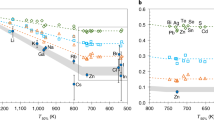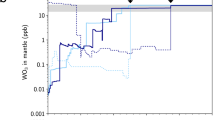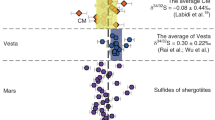Abstract
Volatile elements have a fundamental role in the evolution of planets. But how budgets of volatiles were set in planets, and the nature and extent of volatile-depletion of planetary bodies during the earliest stages of Solar System formation remain poorly understood1,2. The Moon is considered to be volatile-depleted and so it has been predicted that volatile loss should have fractionated stable isotopes of moderately volatile elements3. One such element, zinc, exhibits strong isotopic fractionation during volatilization in planetary rocks4,5, but is hardly fractionated during terrestrial igneous processes6, making it a powerful tracer of the volatile histories of planets. Here we present high-precision zinc isotopic and abundance data which show that lunar magmatic rocks are enriched in the heavy isotopes of zinc and have lower zinc concentrations than terrestrial or Martian igneous rocks. Conversely, Earth and Mars have broadly chondritic zinc isotopic compositions. We show that these variations represent large-scale evaporation of zinc, most probably in the aftermath of the Moon-forming event, rather than small-scale evaporation processes during volcanism. Our results therefore represent evidence for volatile depletion of the Moon through evaporation, and are consistent with a giant impact origin for the Earth and Moon.
This is a preview of subscription content, access via your institution
Access options
Subscribe to this journal
Receive 51 print issues and online access
$199.00 per year
only $3.90 per issue
Buy this article
- Purchase on Springer Link
- Instant access to full article PDF
Prices may be subject to local taxes which are calculated during checkout



Similar content being viewed by others
References
Albarède, F. Volatile accretion history of the terrestrial planets and dynamic implications. Nature 461, 1227–1233 (2009)
Wood, B. J. & Halliday, A. N. &. Rehkämper, M. Volatile accretion of the Earth. Nature 467, E6–E7 (2010)
Humayun, M. & Clayton, R. N. Potassium isotope cosmochemistry: genetic implications of volatile element depletion. Geochim. Cosmochim. Acta 59, 2131–2148 (1995)
Moynier, F., Albarède, F. & Herzog, G. Isotopic composition of zinc, copper, and iron in lunar samples. Geochim. Cosmochim. Acta 70, 6103–6117 (2006)
Moynier, F. et al. Isotopic fractionation of zinc in tektites. Earth Planet. Sci. Lett. 277, 482–489 (2009)
Ben Othman, D., Luck, J. M., Bodinier, J. L., Arndt, N. & Albarede, F. Cu–Zn isotopic variations in the Earth’s mantle. Geochim. Cosmochim. Acta 70, A46 (2006)
Hartmann, W. & Davis, D. Satellite-sized planetesimals and lunar origin. Icarus 24, 504–515 (1975)
Cameron, A. The origin of the Moon and the single impact hypothesis V. Icarus 126, 126–137 (1997)
Yin, Q. et al. A short timescale for terrestrial planet formation from Hf-W chronometry of meteorites. Nature 418, 949–952 (2002)
Touboul, M., Kleine, T., Bourdon, B., Palme, H. & Wieler, R. Late formation and prolonged differentiation of the Moon inferred from W isotopes in lunar metals. Nature 450, 1206–1209 (2007)
Canup, R. Origin of the Moon in a giant impact near the end of the Earth’s formation. Nature 412, 708–712 (2001)
Ida, S., Canup, R. & Stewart, G. Lunar accretion from an impact-generated disk. Nature 389, 353–357 (1997)
Pahlevan, K. & Stevenson, D. J. Equilibration in the aftermath of the lunar-forming giant impact. Earth Planet. Sci. Lett. 262, 438–449 (2007)
Lodders, K. Solar System abundances and condensation temperatures of the elements. Astrophys. J. 591, 1220–1247 (2003)
Albarède, F. The stable isotope geochemistry of copper and zinc. Rev. Mineral. Geochem. 55, 409–427 (2004)
Moynier, F. et al. Nature of volatile depletion and genetic relations in enstatite chondrites and aubrites inferred from Zn isotopes. Geochim. Cosmochim. Acta 75, 297–307 (2011)
Luck, J. M., Othman, D. B. & Albarède, F. Zn and Cu isotopic variations in chondrites and iron meteorites: early solar nebula reservoirs and parent-body processes. Geochim. Cosmochim. Acta 69, 5351–5363 (2005)
Herzog, G. F., Moynier, F., Albarède, F. & Berezhnoy, A. A. Isotopic and elemental abundances of copper and zinc in lunar samples, Zagami, Pele's hairs, and a terrestrial basalt. Geochim. Cosmochim. Acta 73, 5884–5904 (2009)
Neal, C. R., Taylor, L. A. & Schmitt, R. A. Paired lunar meteorites MAC88104 and MAC88105: a new “FAN” of lunar petrology. Geochim. Cosmochim. Acta 55, 3037–3049 (1991)
Ding, T. P., Thode, H. G. & Rees, C. E. Sulphur content and sulphur isotope composition of orange and black glasses in Apollo 17 drive tube 74002/1. Geochim. Cosmochim. Acta 47, 491–496 (1983)
Chou, C. L., Boynton, W. V., Sundberg, L. L. & Wasson, J. T. Volatiles on the surface of Apollo 15 green glass and trace-element distributions among Apollo 15 soils. Lunar. Planet. Sci. Conf. 6, 1701–1727 (1975)
Symonds, R. B., Rose, W. I., Reed, M. H., Lichte, F. E. & Finnegan, D. L. Volatilization, transport and sublimation of metallic and non-metallic elements in high temperature gazes at Merapi Volcano, Indonesia. Geochim. Cosmochim. Acta 51, 2083–2101 (1987)
Sharp, Z., Shearer, C., McKeegan, K., Barnes, J. & Wand, Y. The chlorine isotope composition of the moon and implications for an anhydrous mantle. Science 329, 1050–1053 (2010)
Giguere, T., Taylor, G. J., Hawke, B. & Lucey, P. G. The titanium contents of lunar mare basalts. Meteorit. Planet. Sci. 35, 193–200 (2000)
Snyder, G. A., Taylor, L. A. & Neal, C. R. A chemical model for generating the sources of mare basalts: combined equilibrium and fractional crystallization of the lunar magmasphere. Geochim. Cosmochim. Acta 56, 3809–3823 (1992)
Spicuzza, M. J., Day, J. M. D., Taylor, L. A. & Valley, J. W. Oxygen isotope constraints on the origin and differentiation of the Moon. Earth Planet. Sci. Lett. 253, 254–265 (2007)
Reufer, A., Meier, M. M. M., Benz, W. & Wieler, R. A hit-and-run giant impact scenario. Icarus 221, 296–299 (2012)
Hauri, E. H., Weinreich, T., Saal, A., Rutherford, M. & Van Orman, J. A. High pre-eruptive water contents preserved in lunar melt inclusions. Science 333, 213–215 (2011)
Lodders, K. & Fegley, B. An oxygen isotope model for the composition of Mars. Icarus 126, 373–394 (1997)
Moynier, F. et al. Volatilization induced by impacts recorded in Zn isotope composition of ureilites. Chem. Geol. 276, 374–379 (2010)
Barrat, J. A. et al. Geochemistry of CI chondrites: major and trace elements, Cu and Zn isotopes. Geochim. Cosmochim. Acta 83, 79–92 (2012)
Day, J. M. D. et al. Comparative petrology, geochemistry and petrogenesis of evolved, low-Ti lunar mare basalt meteorites from the La Paz icefield, Antarctica. Geochim. Cosmochim. Acta 70, 1581–1600 (2006)
Warren, P. H. & Kallemeyn, G. W. in Proceedings of the NIPR Symposium on Antarctic Meteorites Vol. 4 91–117 (Nat. Inst. Polar Res., Tokyo, 1991)
Acknowledgements
We thank the NASA curation staff, CAPTEM and the meteorite working group for samples. This work was supported by grants from the NASA LASER and Cosmochemistry programmes to F.M. (NNX09AM64G, NNX12AH70G) and J.M.D.D. (NNX11AG34G; NNX12AH75G) and from the Exobiology programme (NNX12AD88G) to F.M.
Author information
Authors and Affiliations
Contributions
R.C.P. and F.M. performed zinc isotope and abundance measurements. All authors wrote the Letter and contributed to discussion and interpretation of results in the manuscript.
Corresponding author
Ethics declarations
Competing interests
The authors declare no competing financial interests.
Supplementary information
Supplementary Information
This file contains Supplementary Text and Supplementary references. (PDF 181 kb)
Supplementary Data
This file contains Supplementary Table 1 which shows isotopic composition and concentration of Zn in lunar, martian and terrestrial igneous rocks and for chondrites. (XLSX 19 kb)
Supplementary Data
This file contains Supplementary Table 2 which shows MC-ICP-MS ThermoElectron Neptune Plus settings for the Zn isotope measurements at Washington University in St Louis. (XLSX 25 kb)
Rights and permissions
About this article
Cite this article
Paniello, R., Day, J. & Moynier, F. Zinc isotopic evidence for the origin of the Moon. Nature 490, 376–379 (2012). https://doi.org/10.1038/nature11507
Received:
Accepted:
Published:
Issue Date:
DOI: https://doi.org/10.1038/nature11507
This article is cited by
-
The distinct conditions of atmospheric and underground nuclear tests revealed by Zn isotopic compositions of nuclear debris samples
Journal of Radioanalytical and Nuclear Chemistry (2024)
-
First-principles calculations of equilibrium Ga isotope fractionations between several important Ga-bearing minerals and aqueous solutions
Scientific Reports (2023)
-
Stochastic accretion of the Earth
Nature Astronomy (2022)
-
The accretion of planet Earth
Nature Reviews Earth & Environment (2022)
-
Analytical protocols for Phobos regolith samples returned by the Martian Moons eXploration (MMX) mission
Earth, Planets and Space (2021)
Comments
By submitting a comment you agree to abide by our Terms and Community Guidelines. If you find something abusive or that does not comply with our terms or guidelines please flag it as inappropriate.



